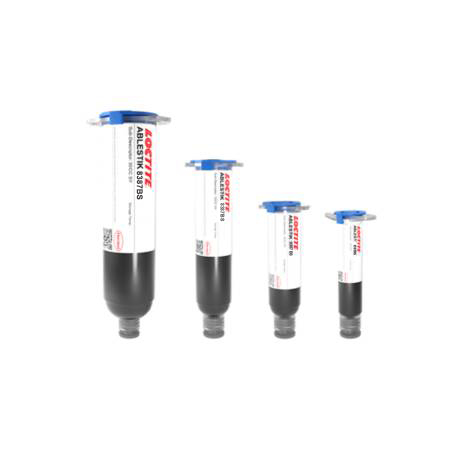LOCTITE ABLESTIK ABP 8420
- Fast cure - Low temp also possible
- Excellent RBO performance
- Lid attach - Optical sensors & 3d modules
Product Description
LOCTITE ABLESTIK ABP 8420 non-conductive epoxy adhesive is designed for cap and lid attach applications in wirebond packages for optical sensors, lens and 3d modules. This adhesive can be fast cured using directed heat energy or hot plate curing techniques. It is jettable, with minimal resin bleed out, minimal adhesion drop post reliability and can be used to bond a Nickel surface on FR4.
LOCTITE ABLESTIK ABP 8420 will cure at temperatures as low as 80ºC in conventional box or convection conveyor oven curing. If used over an active die face, an adhesive bondline thickness of >1 mil must be maintained to prevent die scarring. This product is a modified version of 8387B and can potentially be used as an alternative if the application allows.
Cure Schedule
- 30 minutes ramp to 150ºC, hold 15 minutes @ 150 °C
- 30 minutes @ 100°C or
- 120 minutes @ 80°C
Technical Specifications
| General Properties | |
| Work life @25°C Work life @25°C Work life is the amount of time we have to work with a material until it is no longer able to be easily worked and applied on a substrate. It is based on the change in viscosity and it can rely on the application requirements. | 24 hours |
| Thermal Properties | |
| Glass Transition Temperature (Tg) Glass Transition Temperature (Tg) The glass transition temperature for organic adhesives is a temperature region where the polymers change from glassy and brittle to soft and rubbery. Increasing the temperature further continues the softening process as the viscosity drops too. Temperatures between the glass transition temperature and below the decomposition point of the adhesive are the best region for bonding. The glass-transition temperature Tg of a material characterizes the range of temperatures over which this glass transition occurs. | 75 °C |
| Thermal Conductivity Thermal Conductivity Thermal conductivity describes the ability of a material to conduct heat. It is required by power packages in order to dissipate heat and maintain stable electrical performance. Thermal conductivity units are [W/(m K)] in the SI system and [Btu/(hr ft °F)] in the Imperial system. | 0.3 W/m.K |
| Physical Properties | |
| Thixotropic index Thixotropic index Thixotropic Index is a ratio of a material s viscosity at two different speeds in Ambient temperature, generally different by a factor of ten. A thixotropic material s viscosity will decrease as agitation or pressure is increased. It indicates the capability of a material to hold its shape. Mayonnaise is a great example of this. It holds its shape very well, but when a shear stress is applied, the material easily spreads. It helps in choosing a material in accordance to the application, dispense method and viscosity of a material. | 5.8 |
| Viscosity Viscosity Viscosity is a measurement of a fluid’s resistance to flow. Viscosity is commonly measured in centiPoise (cP). One cP is defined as the viscosity of water and all other viscosities are derived from this base. MPa is another common unit with a 1:1 conversion to cP. A product like honey would have a much higher viscosity -around 10,000 cPs- compared to water. As a result, honey would flow much slower out of a tipped glass than water would. The viscosity of a material can be decreased with an increase in temperature in order to better suit an application | 13,500 mPa.s |




